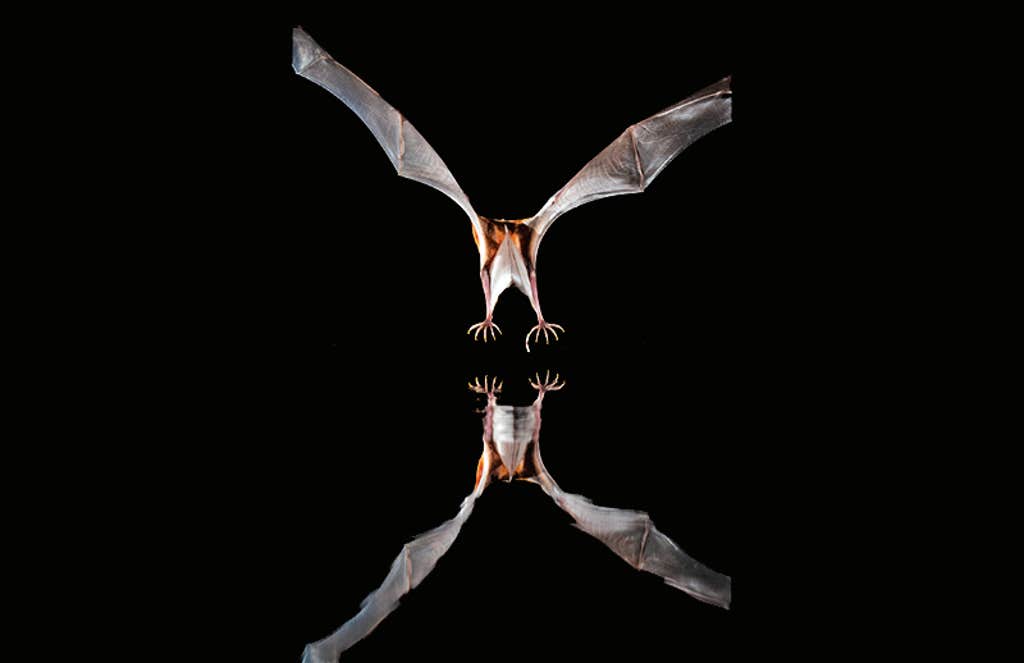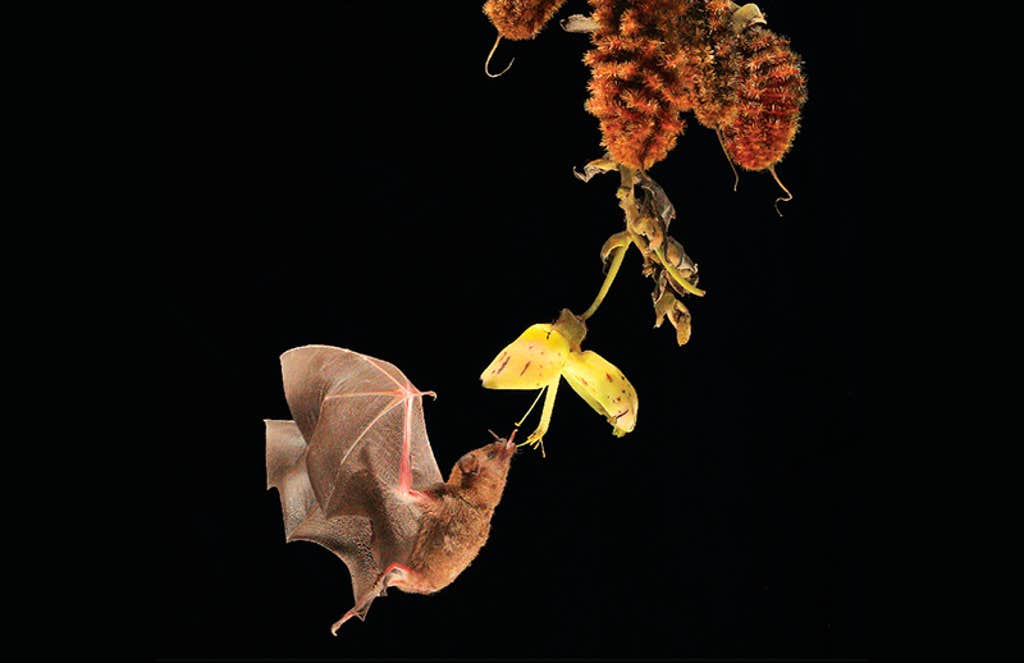The ecological success of bats, their almost worldwide distribution, and their phylogenetic diversity is in large part thanks to flight. Bats are the only mammals able to truly fly, and the name of their scientific order, Chiroptera, translates to hand wing.
The oldest nearly complete skeleton of a bat dates from 52.5 million years ago (Onychonycteris finneyi) and shows that bat morphology has remained almost unchanged for over 50 million years. These early bats already displayed the enormously elongated fingers of modern bats, thin wings made of skin anchored to the ankles, and the small, sharp teeth of an insect feeder. The specialized hearing structures they needed to echolocate would come soon after O. finneyi.
The only major difference between this ancient bat and its modern counterparts are the claws on the end of each of the four elongated fingers at the edge of the wing membrane, a trait that only modern fruit bats in the Pteropodidae family in Africa, Asia, and Oceania have retained on a few of their fingers.

Like human hands, bat wings consist of five fingers. The thumb is small, has a claw, and projects from the wrist. It can aid with climbing and holding food. The remaining four digits are thin and elongated, connected by a skin membrane called the chiropatagium (or dactylopatagium). A smaller membrane, the propatagium, extends from the shoulder to the thumb and helps shape the wing during maneuvering. The part of the wing between the fifth digit and the body, the plagiopatagium, is anchored to the ankle, and thus creates one continuous flight surface.
Many bats have an additional membrane that stretches between the ankles, the uropatagium, or tail interfemoral membrane. Since it is difficult to catch prey in midair with their mouths, many bat species use the uropatagium like a basket to capture insects in flight. Bats flex their knees and do funny little whirls, similar to in-flight sit-ups, to scoop an insect into the uropatagium and deliver it to the mouth. A long spur, the calcar, extends from an ankle bone and helps spread the uropatagium between the tail and hind legs.

For a mammal to make a leap into flight involved a major reorganization of both anatomy and physiology. Elongated fingers provided wings to fly, and to power this costly way of movement, bats developed enormous hearts and lungs that deliver the oxygen needed to fuel their fast metabolisms and powerful flight muscles. In fact, the weight of their heart accounts for over 1 percent of their body mass, compared to approximately 0.7 percent in other terrestrial mammals. Their enhanced lungs and hearts are supplemented by blood that contains a higher-than-average percentage of hemoglobin-carrying red blood cells to transport oxygen. In addition, they can even absorb oxygen from the air directly into the blood vessels in their wings.
Bats can control the shape of their wings by moving their fingers and legs, and they can alter the stiffness of their wing membrane with small bundles of muscles located throughout the plagiopatagium, the portion of the wing closest to the body. Bat wings are also covered in tiny hairs that help sense the flow of air, which gives them further control over their outstanding flight acrobatics. A bat’s wings reflect its ecology and the environment in which it flies. Some species can fly at speeds over 100 miles per hour in search of insects, while others are able to hover in place like a hummingbird to sip nectar from flowers.

When landing, bats face the challenge of fighting gravity to turn upside down, with their feet grasping the cave ceiling, a branch, or other landing surface. Birds can slow down their flight and use gravity to land, but bats need to execute an acrobatic masterpiece before resting. As they approach their chosen roosting spot, they use their wings to shift the direction of their momentum and swing their feet upward like a pendulum to land feet first. They do this so well that many bats exert zero force on their landing spot as they land.
In fact, there is considerable diversity in the ways bats land, depending on the places where they roost. Bats that roost on hard surfaces tend to use these highly acrobatic somersaults, while bats that roost on more flexible leaves and branches will often skip the somersault and crash directly onto their softer landing pad.

For their size, bats lead extraordinarily long lives. Across all mammals, longevity generally scales with body size: the larger the organism, the longer its life. Relative to their body size, only 19 species of mammals are known to be longer lived than humans, and 18 of these species are bats. Other mammals with a similar body size to bats, such as shrews and mice, generally live just over one year. The longevity record for a bat is 41 years, held by a 0.2-ounce (6-gram) cave-dwelling Brandt’s bat (Myotis brandtii) found in Siberia. It is thought that the anti-inflammatory adaptations that help bats cope with the metabolic by-products generated from powered flight may have also conferred on bats both an excellent immune system and a long lifespan.
Bats’ low reproductive rate—having just one or in some cases two pups per year—is another selective force that may have contributed to bats’ long lives. While short-lived animals ensure that genes are passed to the next generation by having large litters with many offspring, flight constrains litter size in bats. Mothers can fly with one or at most two pups at a time; their reproductive phase is thus stretched out over years. Given their extraordinary longevity, it would make sense for bats to have long-term cognitive skills and memory to help them retain valuable foraging information, remember roost sites, and navigate multiyear social partnerships. Research over the last decades has shown this to be the case. ![]()
This article is adapted from an excerpt of Bat Island: A Rare Journey into the Hidden World of Tropical Bats, by Rachel A. Page, Dina K. N. Dechmann, M. Teague O’Mara, Marco Tschapka and the Smithsonian Tropical Research Institute. Photographs by Christian Ziegler. Published with permission from Earth Aware Editions and Simon & Schuster.
Christian Ziegler is a German photojournalist specializing in natural history and science, with a focus on tropical ecosystems. Ziegler currently works for the Max Planck Institute of Animal Behavior in Konstanz, Germany.





























